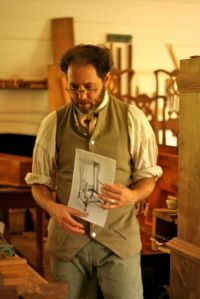As a woodworker Williamsburg, Virginia is a place I’ve always wanted to visit to see how woodworking was done “back in the day”. If you read my blog you know that I consider myself a hybrid woodworker type but have mentioned the possibility of going to all hand tools. Needless to say, my recent purchase of the SawStop that replaced the aging Jet cabinet saw may negate that! My wife and I spent all of last week in the Williamsburg area and visited Jamestown, Yorktown, Washington D.C., and also a couple of plantations for good measure. Coming from the Las Vegas area where there’s nothing older than the late 1800’s we were in for quite an historical treat. Diane and I are like minded in our interests so it was a fantastic week. Among all of the historical things we did I was able to check out the woodwork and she has hundreds of photographs to use for reference material for her paintings. That only scratched the surface of the history in that area, we also toured several plantations and other museums.
About twenty years ago I was going through a rough stretch in my life and saw an advertisement in Fine Woodworking Magazine for an apprenticeship at Williamsburg. The position advertised was for a cooper. I thought long and hard about that but decided not to since my daughter was in Las Vegas and I did have a secure job teaching. I always wondered what that life would have been like so here’s a glimpse at how things may have turned out had I pursued that!
What was so fascinating about the Williamsburg experience is that it is truly a working village. All of the shops; whether they’re working with wood, fabric, food, etc. actually sell their wares. Many of them are used to furnish the buildings but it is possible to buy them too. As an example, one of the guys in the cabinet shop showed this drawing they were using to build a chair for one of the buildings. They will build the framework and then it will be upholstered in another shop. He has been there for about 10 years and mentioned that if they were a “money making” shop there is no way they’d stay in business! Their primary function is to educate visitors and they do a great job at that.
Since we weren’t the only ones in the shop it was very interesting to hear the questions other people had and the response. First off, the shop is pretty crowded and what struck me right away was how dark the working conditions are. I watched a video recently showing how to make secret miter dovetails that was filmed in this shop and actually saw the man working there during our visit. His name is Kaare Loftheim and he’s the gray haired gentleman in my pictures. We’re always told to work in the light and sure enough, their main work areas are located underneath the windows. A question that always comes up when people view your work is “how long did that take you to build?” Our presenter held up a nicely dovetailed drawer and explained that it takes him less than an hour for the actual dovetails but preparing the lumber takes 2-3 hours — makes me reconsider selling off my power tools! Rather than bore you with all of the details of the trip I’ll leave you with this slideshow of the interior of the shop. I’d also encourage you to plan a visit to Williamsburg and the surrounding area if you’re interested in our historical roots. You won’t be disappointed!
I gained a lot of knowledge about the life people led in those days. I was somewhat surprised to see some of the furniture styles but then reminded myself that they all came from Europe so that’s what influenced them. As they became settled in the New World they developed their own styles. Only the well-to-do would have the fancier furniture while the commoners would likely design and build their own as time and needs dictated. My own preference leans more towards the simpler style of the Shakers with some added Asian influence. The fancier and more elaborate furniture of the Colonial period was a way to show off your position and wealth.





sound like a great trip
LikeLiked by 1 person
Very jealous and happy you got to make the trip – It’s on my bucket list for sure! Thanks for the great review and pictures!
LikeLike
Looks like an enjoyable experience. Would definitely do that trip one day
LikeLiked by 1 person